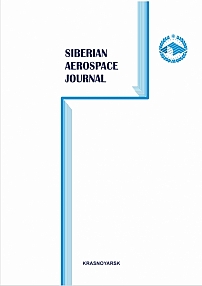Siberian Aerospace Journal
The journal has been published since 2000.
2000 - Bulletin of the Siberian Aerospace Academy named after academician M.F. Reshetneva (Bulletin of CAA)
2002 - Bulletin of the Siberian State Aerospace University named after academician M.F. Reshetnev "(Bulletin of SibGAU)
2017 - Siberian Journal of Science and Technology (SibZhNT)
From 01.03.2021 - Siberian Aerospace Journal (SAZh)
The Mission of Siberian Journal of Science and Technology is to provide active development of scientific and technological activities in the field of aviation and space technology, engineering, management, computer engineering, computer science. All papers have open access.
The Journal aims and goals:
- to publish the latest scientific achievements of Russian and foreign researchers in the field of aviation and spacecraft engineering, mechanic engineering, management, informatics, computer science, to spread information about cutting-edge researches in these fields;
- to publicize contemporary issues and draw experts’ attention to modern issues of mechanic engineering, development of spacecraft engineering, control systems and informatics, technical processes and goods;
- to exchange and discuss research experiments in order to generate sound scientific researches of scientists and researchers from the Russian Federation and other countries; to integrate into international educational and research and technology space;
- to expand the geography of the authors and target audience, improve the quality of the published material, improve national and international scientific citation indexes and rankings;
- to provide the authors of publications with quality editorial and publishing services, including services for peer review, as well as translation of abstracts and selected articles into English.
Reshetnev Siberian State University of Science and Technology
Выпуски журнала
Статьи журнала
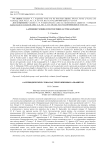
6-aperiodic words over the three-letter alphabet
Статья научная
The work is devoted to the study of sets of aperiodic words over a finite alphabet. A set of such words can be considered as some kind of finite formal language. W. Burnside raised the issue of local finiteness of periodic groups. The negative answer was given only sixty years later by E. S. Golod. Soon S. V. Aleshin, R. I. Hryhorczuk, V. I. Sushchanskii constructed more examples confirming the negative answer to Burnside's question. Finiteness of the free Burnside group of period n was established for periods two and three (W. Burnside), for period four (W. Burnside, I. N. Sanov), for period six (M. Hall). The infinity of such a group, for odd indicators exceeding 4381, is established in the work of P. S. Novikov and S. I. Adyan (1967), and for odd indicators exceeding 664 in the book by S. I. Adian (1975). A more intuitive version of the proof for odd n > 1010 was proposed by A. Yu. Olshansky (1989). In this article, we consider the set of 6-aperiodic words. In the monograph by S. I. Adyan (1975) it was shown the proof of S. E. Arshon (1937) theory that there are infinitely many three-aperiodic words of any length in the two-letter alphabet. In the book of A. Y. Olshansky (1989), a proof of the infinity of the set of six-aperiodic words is given and an estimate of the number of such words of any given length is obtained. Here we try to estimate the function of the number of six-aperiodic words of any given length in a three-letter alphabet. The results obtained can be useful for encoding information in space communication sessions.
Бесплатно
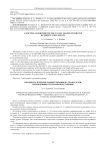
A routing algorithm for the Cayley graphs generated by permutation groups
Статья научная
The purpose of this work is to create an effective routing algorithm on the Cayley graphs of permutation groups, superior in its characteristics to an algorithm using an automatic group structure. In the first section of the article we describe the auxiliary algorithm A–1 which allows numbering elements of a given permutation group. In the second section we present the algorithm A–2 for calculating the routing table on the Cayley graph and algorithm A–3 for determination the optimal route between two arbitrary vertices of the graph. Estimates of time and space complexity are also obtained for these algorithms. In the third section we describe the algorithm A–4 for calculation the minimal word of a group element. It is proved that the computational complexity of the algorithm will be proportional to the length of the input word. The fourth section presents the results of computer experiments for some groups of permutation groups, which compare the time for calculating the minimum words using algorithm A – 4 and an algorithm based on the construction of an automatic group structure. It is shown that A – 4 is much faster than its competitor.
Бесплатно
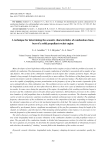
Статья научная
Many developers of new high-thrust solid-propellant rocket engines are faced with the problem of acoustic instability of combustion. The phenomenon of resonant combustion of solid fuel is associated with a number of specific features. The cavities of the combustion chambers of such engines have complex geo-metric shapes. The gas channel is long enough. Its length usually exceeds five or more calibers. The thick-ness of the flame front is measured in micrometers and the combustion zone is localized over the open fuel surface. The flame front often turns out to be capable of amplifying pressure perturbations at the frequency of one of the acoustic eigenmodes if the wave antinode falls on a thin combustion zone. The oscillatory process can be regular or sporadic. Resonances of the longitudinal acoustic mode are most often observed. However, there were cases of simultaneous oscillation of two modes. In some cases, during the operation of the engine, the amplitude of the resulting oscillations began to decrease and the combustion process be-came almost quasi-stationary. Self-oscillatory processes in the combustion chambers of solid propellants have a threshold sensitivity to pressure overshoots. The vibration amplitudes can be several tens of percent, sometimes reaching the nominal working pressure in the chamber. The amplitude-frequency characteristics of the oscillations are sensitive to the composition of the fuel, responding to changes in the chemical com-position, as well as to the mechanical properties of the fuel. The regions of unstable regimes are definitely related to the geometry of the gas cavity. Together with pressure fluctuations, the combustion process is influenced by gas-dynamic factors, significant non-uniformity of the gas flow parameters along the length of the channel, its turbulence, and other factors. When designing solid-propellant rocket engines, it is nec-essary to estimate the frequencies of the natural acoustic resonances of the combustion chambers. The article discusses a technique for determining the frequencies of natural resonances of the first and second tone of the longitudinal mode of acoustic vibrations in the combustion chambers of solid propellant rocket engines. The gas path of the combustion chamber is divided into homogeneous sections, for which the solutions of the wave equation are presented. To determine the natural frequencies and distribution of vibrational pressures and velocities, the method of “stitching” acoustic fields at the boundaries of the cavi-ties was used.
Бесплатно
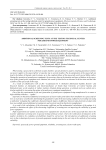
Additional screening tests at the testing technical center for ground power equipment
Статья научная
When testing a spacecraft in a thermal vacuum chamber, special attention is paid to ensuring guaranteed continuous power supply to the spacecraft for a long time (up to several months). The de-energization of the spacecraft can lead to the failure of thermal control systems, up to the complete failure of the spacecraft worth several billion rubles. During the operation of ground power equipment, the necessary data on the intensity and types of failures in the operation of this ground power equipment were obtained, the result of which led to an increase in the test time and the risks of failure of the spacecraft at this stage. As a result of collaborative work of JSC “Academician M. F. Reshetnev Information Satellite Systems” and Research Institute of Automation and Electromechanics of Tomsk State University of Control Systems and Radioelectronics on the analysis of failure statistics obtained during operation, a technical task was worked out to develop methods for increasing the uptime of ground power equipment manufactured. One of the key requirements for the new generation of ground power equipment being manufactured is to ensure a high reliability indicator – “uptime”. Experience in the field of additional screening tests of electro-radio parts before their installation in a spacecraft allows us to propose a method for determining the quantitative value of the decreasing coefficient of screening tests using a method for evaluating the coefficients characterizing the degree of difference between radio-electronic products that have successfully passed additional screening tests and received ones from the factory manufacturer. As a result of the calculations of the decreasing coefficient and the mathematical calculations of the uptime, it is possible to determine the effect of the decreasing coefficient of screening tests on improving the reliability of ground power equipment. High requirements for uptime of ground power equipment for electrical tests of the spacecraft have led to the need for additional screening tests in special testing technical centers, where the verification of indicators of the number of failures by confidence probabilities should be carried out. The introduction of additional screening tests in the technological process of ground equipment manufacturing is the next step in the methods of increasing reliability.
Бесплатно

Algorithmic and software of the system profiling the actions of users of the information system
Статья научная
The paper describes the software of the system for profiling the actions of users of the information system. This profiling system is aimed at solving the problem of trust in users of information systems. The system should regulate access to protected resources by analyzing user behavior. The algorithmic component of the system is represented by a user behavior model and a general system operation algorithm. The user behavior model is based on the apparatus of Markov chains Software implementation allows in practice to obtain the foundations of the proposed approach to work. At the development stages, the choice of software architecture is carried out. The client-server architecture was chosen as a reasonable decision. The software component of the user activity profiling system consists of five separate software modules. At the end of development, a brief testing of the components is carried out. The novelty of this work lies in the proposal of an approach that uses the profiling of user actions as an additional determining factor in managing access to objects, as a way to strengthen the basic measures “Controlling access of subjects to access objects” in the order system of FSTEC of Russia.
Бесплатно
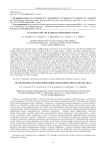
Analysis of the ADS-B airspace monitoring system
Статья научная
One of the most important aspects of flight safety is awareness of AC air position (AC is the short for aircraft). The leading method of stating AC airspace location is the use of radar systems – primary, secondary, combined primary – secondary surveillance radars-though radar systems have significant drawbacks. However, at present, more advanced technologies are also in use, for example, ADS-B and multilateration. This article is focused on ADS-B broadcasting. Global coverage, low cost, great amount of obtainable information makes Automatic Dependent Surveillance – Broadcast a highly efficient system. Application of the method for AC air positioning is equally effective for helicopters, especially for those operated by special emergency services. As for the infrastructure of air navigation, the research in this sphere is focused on surveillance systems necessary for reliable control of increasing air traffic. The problem of better awareness of AC air position is still acute and has always been the object of extensive research. At present, homemanufactured civil aviation helicopters are practically never equipped with ADS-B transponders, and hardly ever use the available resources of transceiver-based surveillance systems. The objective of the analysis presented is to demonstrate the applicability of Flightradar system options, as well as implementation of ADS – B transponders for helicopter fleet. Operating surveillance systems like Flightradar may considerably increase flight safety by improving the awareness of helicopters current air position.
Бесплатно

